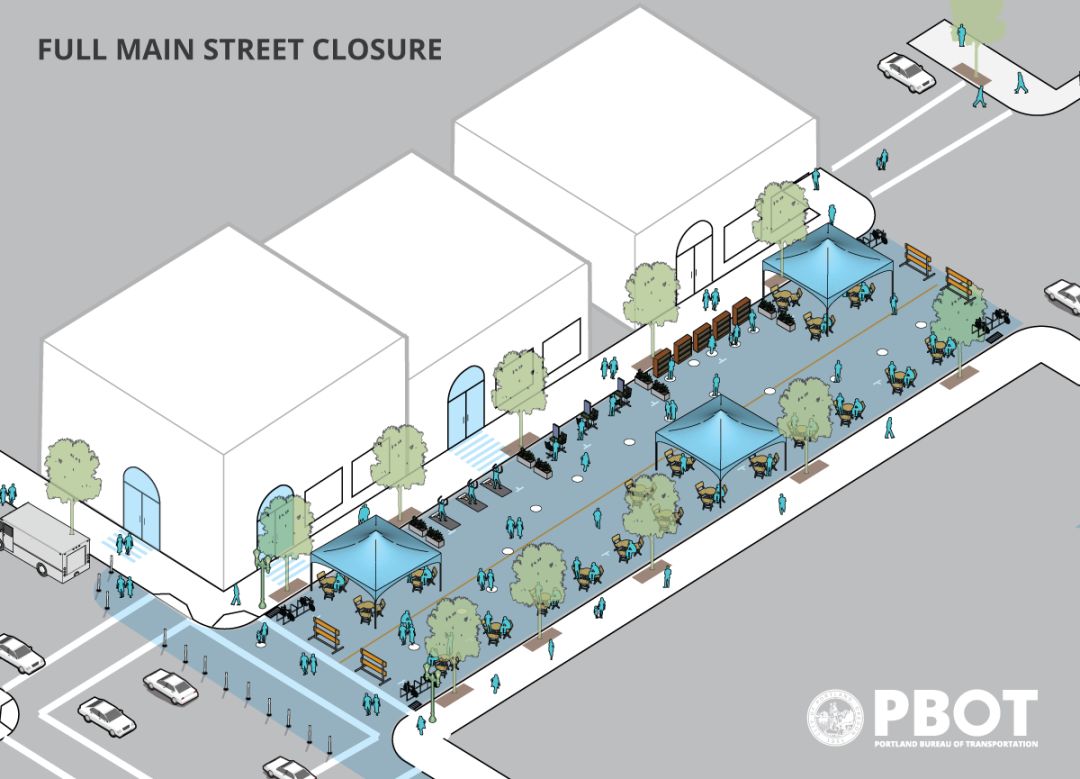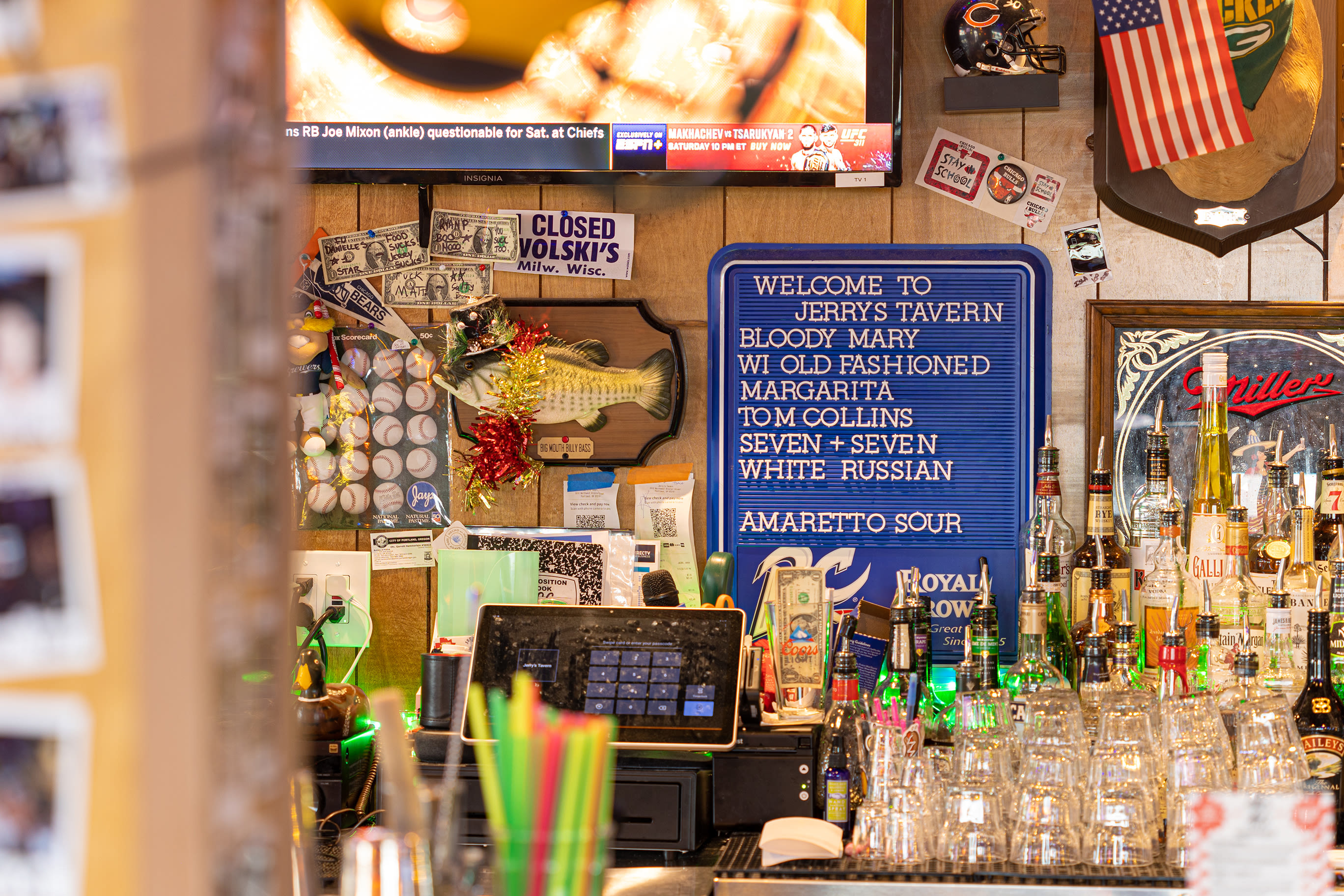This Summer, Portland Will Make Room For Dining On The Streets

A hypothetical rendering of Portland's new, socially distant normal
UPDATE PART TWO: False alarm, folks! PBOT officials now tell The Oregonian that they goofed, and sidewalk tables can proceed as in years past. Phew! To the sidewalks! (While wearing a mask, with appropriate distancing and with as large a tip for the kitchen as you can afford.)
UPDATE: On Friday afternoon, restaurants across the city got word from the Portland Bureau of Transportation that their sidewalk dining permits were being revoked until October 1, due to concerns that "dining on most sidewalks will not allow enough space to accommodate physical distancing rules." Pedestrian travel on sidewalks needed to be the priority, the agency said, and businesses should instead apply to place tables in parking spots and lots. Restaurant owners, many of whom had hailed Thursday's announcement that some streets and parking lots would be closed to allow for tables this summer reacted with dismay.
Without sidewalk permits, the owners of La Buca on NE 28th Avenue told Portland Monthly, they'd be operating only at 40 percent capacity when Multnomah County allows reopening in mid-June.
****
Closed streets and socially distant dining and shopping are good enough for Paris, Milan, and Barcelona—and now, Portland’s joining the party.
During the coronavirus lockdown, Portland's Bureau of Transportation (PBOT) first turned 100 miles of streets into “Neighborhood Greenways” reserved for pedestrians, cyclists, and local traffic.
Now, PBOT is expanding its Safe Streets initiative to let businesses convert parking spots and roadways into car-free areas for seating, shopping, and other services. The program specifically leaves room for “dining, retail, portable hygiene stations and merchandise displays.”
"Cities around the world are reallocating streets for people to support safe physical distancing," says City Commissioner Chloe Eudaly, who oversees the transportation bureau. "Our next phase is working with our local business community to support their reopening and reimagine public space."
The announcement comes just one day after Multnomah County officials offered a plan to reopen the county's economy by June 12. The county's reopening timeline dictates when most Portland businesses can start using parking spaces, and streets, but applications to do so are open as of Thursday morning.
According to PBOT renderings, dining tables and merchandise displays might be situated along sidestreets, curbs, and parking spaces. However, some neighborhoods may shut down an entire street for business, as long as it isn't an emergency-vehicle or bus route. (Of note: if a group of businesses wants to shut down a street entirely, or use cones, planters, or other means to block off plazas and seating areas, they'll have to pay for that infrastructure.)
For business owners like Kenny Fonseca, a little extra space goes a long way. Fonseca's Char Latin Grill on SE Belmont has six indoor tables, some indoor bar space, and three outdoor tables. Under Phase 1 opening guidelines, his restaurant can only operate at 50 percent capacity for dine-in customers, with tables spaced six feet apart. That would cut his bar seating and his number of indoor tables in half. However, if he can use the street, he can shift as many as four more tables outside and maintain his full capacity.
“Restaurants like mine, we depend on volume,” Fonseca said. “So if we can somehow get the sidewalk and street space, we can move those empty seats and tables outside and be able to seat customers while safely doing the social distancing guidelines.”
Just around the corner at the Side Street Tavern, half a block up from Belmont on 34th, owner Jason Youngers notes that open streets “will quite literally be the difference between some businesses surviving and failing.” With just about every business dealing with reduced capacity and hours, Youngers says it's more important than ever to communicate with neighbors about day-to-day operations, hours, and other idiosyncrasies of this new system.
“Logistically, many neighborhoods already have a blueprint to work off of, in that a similar closure occurs for street fairs,” Youngers said. “We can use and learn from this blueprint to implement the changes quickly.”
Up on Northeast 28th Street, La Buca owners Jennifer and Robert Fuller have already applied to use the parking spaces surrounding their corner restaurant for extra seating. Their Italian eatery has been in business for 23 years and has hosted the Hunnymilk brunch pop-up in its off hours. This expansion is just another bit of necessary innovation.
“We are working diligently to provide a safe, comfortable atmosphere for our guests and staff,” the Fullers said in an e-mailed statement. “This addition would allow our dining room, lounge and outside seating areas to expand safely whilst observing social distancing guidelines.”
On the same street, Epif Restaurant and Pisco Lounge is already preparing for a post-coronavirus reality. Owners Nicolle Dirks and Pepe Arancibia normally have 12 indoor tables and eight bar seats available to their customers. Under social distancing guidelines, the bar seating has to go, and only five tables can stay.
“We need our employees and our customers to be safe and this is a creative way for that to happen,” the two said in an e-mailed statement. “Plus, most Portlanders enjoy dining outside and we think it will help foster a sense of neighborhood community.”
The businesses and communities along Belmont and 28th Street have already inspired some bold plans for their streetscapes. Zach Katz, a Virginia native who moved here in 2016, has been talking to businesses about the Portland Promenade Project, which would shut down entire street segments in favor of open-air marketplaces. While details surrounding traffic diversion and emergency access haven’t been worked out yet, Katz says today’s PBOT announcement puts those plans a step closer to reality.
“I'm hoping that we can work with the city to make these plazas and promenades happen as quickly as possible,” Katz says. “They’re coming along nicely, but they aren’t 100 percent there yet.”




